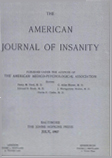INFANTILE CONVULSIONS: THEIR FREQUENCY AND IMPORTANCE
Abstract
1. Infantile convulsions do not occur in a group of unselected cases more frequently than once in every 10 to 14 cases.
2. There seems to be no prognostic value to the pathological, physiological or psychological factors with which the first convulsion is associated.
3. Those cases where the convulsions occur without any apparent exciting factor (that is without trauma, teething, gastro-intestinal upsets, etc.) are invariably more significant and the prognosis should be more guarded than those cases where the convulsion is associated with some definite etiology.
4. In a fairly large group of cases, the convulsion is but a symptom of an unstable nervous system, one that is unable to withstand the ordinary vicissitudes to which the normal child is subjected.
5. There is undoubtedly a fairly large group of convulsive disorders in childhood where the convulsions are symptoms of an undiagnosed meningitis or encephalitis, which leaves behind irreparable damage to the nervous system.
6. The convulsion itself, though not associated with any devastating disease, such as meningitis, or encephalitis, may produce damage from which the brain never recovers, as seen in:
(a) Some of the spastic conditions which follow immediately upon a series of convulsions.
(b) Those cases following convulsions without neurological signs, but which have to adjust on a very much lower mental level.
7. The convulsions associated with rickets and tetany may leave behind very definite damage to the nervous system.
8. There is reason to believe that if the infantile convulsions associated with rickets, gastro-intestinal upsets, and acute infections were looked upon more seriously, and a greater effort made to prevent their occurrence during early life, much epilepsy and mental deficiency might be prevented.
Access content
To read the fulltext, please use one of the options below to sign in or purchase access.- Personal login
- Institutional Login
- Sign in via OpenAthens
- Register for access
-
Please login/register if you wish to pair your device and check access availability.
Not a subscriber?
PsychiatryOnline subscription options offer access to the DSM-5 library, books, journals, CME, and patient resources. This all-in-one virtual library provides psychiatrists and mental health professionals with key resources for diagnosis, treatment, research, and professional development.
Need more help? PsychiatryOnline Customer Service may be reached by emailing [email protected] or by calling 800-368-5777 (in the U.S.) or 703-907-7322 (outside the U.S.).



